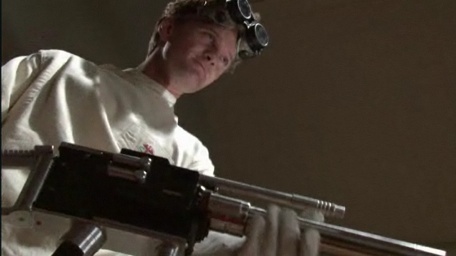On facing Dr. Horrible.
by Vinay Gupta • July 21, 2008 • Personal, Trivia and Media • 4 Comments
Dr. Horrible is a really, really perfectly nerdy web TV show by the brains behind Buffy and Firefly/Serenity. For reasons that I’m foolishly going to try to explain, it hit me like a bag of hammers.
Here’s Dr. Horrible’s problem. He wants the world to be a better place, and he’s willing to kill people to make it happen. Not just anybody, but some people. This more or less defines him as a villain.
Now this is not a trivial point. Gandhi famously said “There are many causes I am willing to die for. There is not a single one I am willing to kill for.” This is a very clear statement of ahimsa – non-violence, but really the word is more profound than that – an inherent non-harming as a quality of being. To use the english phrase “wouldn’t hurt a fly” literally – this is ahimsa.
Unfortunately, for all my aspirations, I’m more like this guy:
Dr. Horrible really brings this into sharp focus: am I willing to, say, kill to protect people. I have to look at myself and conclude that, yes, I am. I’m nowhere near the level of evolution where the killing response is replaced by universal consideration for the life of any being as sacred. Early on in my career I worked on military training software, and if you put a gun in my hand in a crisis, I would not put it down. I don’t know that I could use it, but odds-are that my instincts would not prevent me from using it.
Not a small thing to admit for a guy running a website called Global Swadeshi.
So is Dr. Horrible right? Or Gandhi? Krishna councils Arjuna to fight, to kill, to win. Gandhi councils people to be beaten-unto-death in the streets rather than retaliate. There is no consistency, times change.
Suppose Gandhi had access to the modern telecoms infrastructure – to the internet. This advert sums up that reality better than anything I’ve ever seen.
It’s not about killing or not killing to Arjuna. It’s about whether one hates as one kills, or whether one can kill with full consciousness of what is being done. This is a deadly middle path: to pick up the rifle and to kill god is essentially the council of the Mahabarata – to understand the status and nature of your opponents as divine beings, as incarnate god – and to kill them anyway.
“I am become death, destroyer of worlds” as Krishna, and then Oppenheimer, said.
Again, I can’t imagine where you have to be to have that level of clarity – to see people as they are, fully human and fully divine, and still to pull the trigger. I think I’d better stay far away from battlefields in the physical until I’ve had another forty years to meditate.



This is indeed a problem and I faced it in the late 60’s. Thanks to Gandhi I was able to become classified as a conscientious objector to war and I was sent to a hospital instead of a war zone.
Perhaps the middle ground would be to declare oneself in opposition to organized violence, yet reserve the right of self-defense in personal situations where violence might occur. In a sense by preventing someone from doing violence to you, you are not a complete pacifist but you are preventing violence.
Where I really have problems is when politicians make decisions about bombing some country, or invading and occupying some country (for whatever reason). Then they train other people’s kids to kill and send them to go kill “enemy” kids in the “enemy” country, kids who really have no beef with each other.
Upon returning from war they call the kids heroes and give them medals and economic benefits, and social approval for the bombs they dropped or bullets they fired to kill people they never met in person.) It is really pretty sick, this institutionalization of violence that often generates more hatred, desire for revenge, and further violence.
I kind of would like to err on the side of ahimsa or the Buddhist practice of lovingkindness.
Actually I think what Gandhi said still makes a lot of sense and it has always guided my life: There are things you can be willing to die for (in a satyagraha campaign, for example), but nothing to be willing to kill for.
Asoka, this is a very important comment, and I hope people read and understand what you have said.
Thank you.
I agree with Asoka’s view – to a point. I believe that there are necessary exposures to the cycle that violence generates. to counter and divine a more peaceful and EFFECTIVE path…one would need the knowledge and wisdom derived from an understanding of this terrible path. and to foster a movement such as this…you need those who know the path intimately. who can let those moving forward – keep doing so, unhindered.
Ahimsa against the British Empire in the mid-20th century worked – I’m guessing there are other times it would not have worked. I’ve heard that Gandhi recognized this, and allowed for the possibility of taking a different approach, but I don’t know if that’s accurate, nor what he might have had in mind.